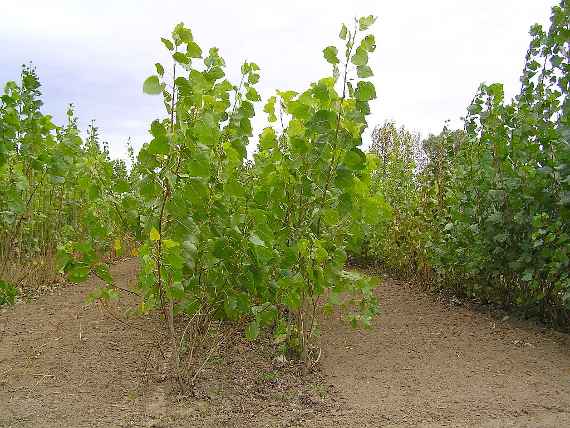The selection of forest reproductive material is of crucial importance for artificial regeneration.
In order to be able to preserve genetic biodiversity and properties desired in forestry, it is essential to secure the identity of forest reproductive material marketed at the national and international level.
The Act and the Regulation covering the marketing of Forest Reproductive Material in Austria came into force on 1 January 2003; it is based on the European Directive 1999/105/EC and is known as “Forstliches Vermehrungsgutgesetz 2003" [Act of Forest Reproductive Material] and the "Forstliche Vermehrungsgutverordnung" [Regulation of Forest Reproductive Material].
Categories
Only 3 categories of Forest Reproductive Material are used in Austria:
- “source identified” exclusively for species newly covered by law
- “selected” for seed stands
- “qualified” for seed orchards and poplar clones
Austrian Regions of Provenance
Austria has a single regional division, valid for all tree species. The delimitation of the regions depends primarly on the natural distribution of the main species, special consideration being given to forest climatological differences. Thus, the different areas identified are largely to be considered as areas with identical ecological conditions. The present division recognises 22 regions of provenance. Ecologically similar regions of provenance are concentrated in 9 forest regions coloured differently on the map.
The map of the Austrian regions of provenance (click on the map for a full size pdf version).
The boundaries of the regions of provenance are established on a map and published under the regulation supplementing the FRM-Act. The exact locations of the stands are not marked on the map but their location can be seen from sketches of maps available in the “National Register” of the Federal Forest Office. The regions of provenance are based on the forest growth regions. The main criteria used are the regional climate and forest community in each region followed by geomorphological factors and the forest site. Within the region of provenance the altitudinal zones are very important and they are based on climate and vegetation. There are 7 different altitudinal zones recognised (colline, sub montane, low montane, medium montane, high montane, low subalpine and high subalpine).
Diagramatic representation of altitudinal zones
Therefore within each region of provenance there are altitudinal zones which may be different in their “metres above sea level” between regions. For example the “medium montane” altitudinal zone varies in region 1.3 from 1100-1400m but in regions 4.1 and 4.2 the zone varies from 800 – 1200m and in region 6.2 from 1000 –1100m.
Numerical definitions of altitudinal zones
For planting the same tree species in different areas and from different regions of provenance it is very important to use the altitudinal zones and not the height above sea level.
Seed stands (category "selected")
Detailed information regarding approved seed stands
Seed orchards (category "qualified")
Detailed information regarding approved seed orchards
Poplar clones (category "qualified")
Detailed information regarding approved "stool-beds" of poplar clones
Tree species abbreviations
On all documents the abbreviations in the following table are used in the national register references. The different categories of material available for each species are also shown.
Register reference of Forest Reproductive Material
On each invoice and delivery note, whichever is acting as the Supplier’s document there is a number code which identifies the exact location of the seed stand, seed orchard or stool-bed from which the seed or other Forest Reproductive Material was collected or taken. This code is the reference which appears in the National Register of Basic Material held by the Federal Forest Office. These references vary according to the category of the material registered; examples of the four types are given below:
- Source Identified - used only for species newly added to the law
- Selected
- Qualified
- Poplar clones in category "qualified"
Source identified Selected Qualified Qualified Poplar clones
Master certificate
The Master Certificate is issued by the District Forest Authority after harvest and consists of 4 pages:
- White folio belongs to the harvest entrepreneur,
- Pink folio is for the Federal Forest Office,
- Yellow folio is kept by the District Forest Authority and
- Blue folio belongs to the forest owner respectively to the owner of the seed orchard or the stool-bed.
The Master Certificate number that appears on the invoice is allocated by the District Forest Authorities which belong to the Provincial Forest Technical Departments and run consecutively each year. For forest seeds from Third Countries the number used instead of the Master Certificate number is that of the import permit which is issued by the Federal Forest Office. The format of each is shown below:
Technical terms of Forest Reproductive Material
Information on invoices and delivery notes from Member States are often difficult to interpret. The list of vocabulary containing the most important technical terms in 16 different languages will make it much more easier to understand the relevant terminology of Forest Reproductive Material.
Thanks to the BLE in Germany for providing this vocabulary list.
Download Technical terms (Excel) (Remark: no password, so you can open the list and skip some columns, where appropriate)
Seed testing
Before dispatch seed of all controlled species are tested for purity and germination / viability in the Federal Forest Seed Testing Laboratory in Vienna.
Normally the viability test is used for Abies, Acer, Fagus, Fraxinus, Prunus, Robinia and Tilia.
For Alnus, Betula, Castanea, Larix, Picea, Pinus, Pseudotsuga and Quercus the germination test will be applicated.
Contact persons for forest reproductive material:
For contacting all persons, you can choose the distribution e-mail address frm(a)bfw.gv.at
or you use the single mail address from the persons listed below.
| Phone | ||
| Stephanie Salzmann | stephanie.salzmann(a)bfw.gv.at | +43 1 87838 2223 ; Mobil: +43 664 8269918 |
| Christian Wurzer | christian.wurzer(a)bfw.gv.at | +43 1 87838 2222 ; Mobil: +43 664 8269933 |
| Gerald Golesch (for approval of stands) | gerald.golesch(a)bfw.gv.at | +43 1 87838 2216 ; Mobil: +43 664 8269903 |


